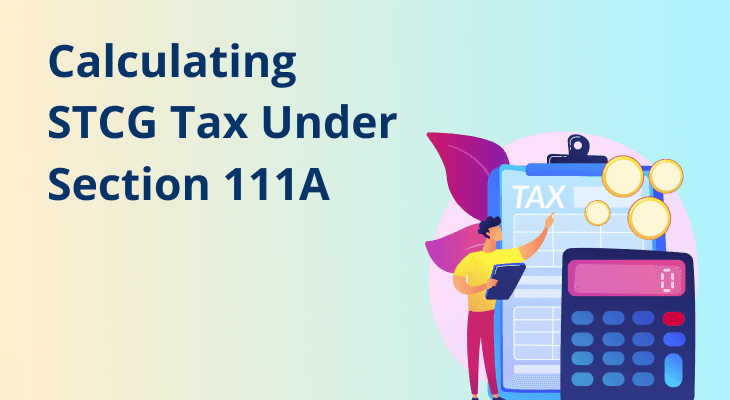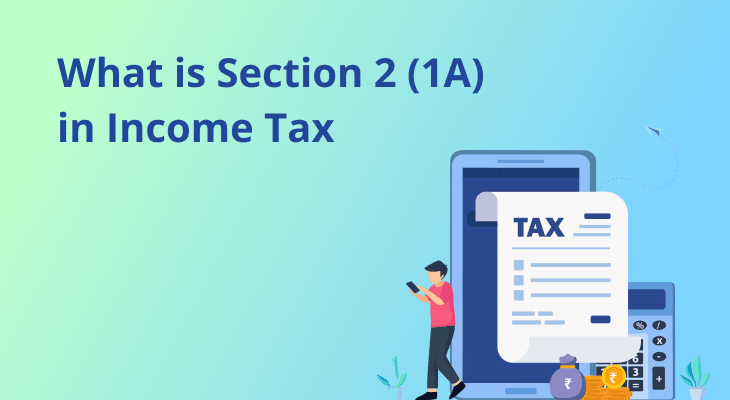
Calculating STCG Tax Under Section 111A
If you’ve recently sold shares or equity mutual fund units and incurred a tax on your profits, you may be dealing with Short-Term Capital Gains (STCG). These gains are taxed differently under the Income Tax Act, particularly when it comes to equity investments. A key provision governing this is Section 111A of the Income Tax Act, which outlines how STCG is taxed when specific conditions are met.
As of July 2024, the STCG tax rate under Section 111A has been revised, affecting lakhs of Indian investors and traders. Understanding the scope, application, and calculation method of this tax is vital if you actively invest in equity markets or equity-oriented funds.
In this guide, we’ll talk about the latest rules and learn how to calculate STCG tax accurately.
What Is STCG and What Does Section 111A Cover?
Short‑Term Capital Gains (STCG) arise when you sell certain equity‑related assets within 12 months of purchase and make a profit. Under the Income Tax Act, STCG on the following assets falls under Section 111A:
- Listed equity shares traded on recognised Indian stock exchanges (NSE, BSE).
- Equity‑oriented mutual fund units, defined as funds with at least 65% investment in equities.
- Units of business trusts, such as Real Estate Investment Trusts (REITs) or Infrastructure Investment Trusts (InvITs).
To qualify for Section 111A:
- Securities Transaction Tax (STT) must be paid at the time of sale.
- For transactions on an IFSC (International Financial Services Centre) exchange, STT is waived if settled in foreign currency, yet Section 111A still applies.
By contrast, profits from unlisted shares, debt funds, property or gold sales, and collectibles do not fall within Section 111A and are taxed under normal slab rates or other sections.
Key Conditions For Section 111A To Apply
- Type of Asset: Only gains from listed equity shares, eligible mutual funds and business trusts are covered.
- Venue of Sale: Must occur on a recognised Indian stock exchange (NSE/BSE) or on an IFSC exchange that settles in foreign currency.
- STT Requirement: STT is levied at 0.1% on delivery‑based equity trades and on mutual fund redemptions; this tax must be paid for Section 111A to apply.
- Holding Period: The asset must have been held for less than 12 months.
- Exclusions: If any one of the above is not met (for example, an off‑market sale with no STT), gains revert to standard slab taxation, not the flat rate.
When all conditions are satisfied, STCG is taxed at a flat 20%, plus a 4% health and education cess on the tax amount. Prior to July 2024, STCG rate stood at 15%.
Applicability Of Section 111A
Resident Individuals & HUFs
- May use any unused basic exemption limit under their chosen tax regime to reduce their STCG before applying the 20% rate.
- Under the old regime, basic exemption is ₹ 2.5 lakh (below age 60). Under the new regime (Section 115BAC), the zero‑tax bracket is ₹ 4 lakh.
- The Section 87A rebate (up to ₹ 12,500 in the old regime; up to ₹ 60,000 in the new regime for incomes up to ₹ 12 lakh) can further reduce liability if your total income (including STCG) falls below the relevant threshold.
Non‑Resident Taxpayers
- Cannot offset any basic exemption or rebate against STCG. The entire gain is taxed at 20%, plus cess.
Gains from assets outside Section 111A’s scope such as debt funds, unlisted shares or property are taxed according to your income tax slab or the provisions governing those assets.
How To Calculate STCG Tax Under Section 111A
Compute Gross Sale Consideration
- Obtain your sale proceeds from the exchange record or contract note.
Deduct Sale‑Related Expenses
- Brokerage, STT, transaction charges and any statutory levies.
Net Sale Consideration = Gross Sale Proceeds − (Brokerage + STT + Other Charges)
Subtract Cost of Acquisition
STCG = Net Sale Consideration − Cost of Acquisition- Use the actual purchase price; no indexation is allowed for STCG.
Offset Unused Exemption (Residents Only)
- Deduct any remaining basic exemption limit under your chosen regime from the STCG.
Apply the Flat Rate
- 20% on the balance STCG (applicable for disposals on or after 23rd July 2024).
Add Health & Education Cess
- 4% on the computed tax amount.
Examples
Example 1: Resident Investor (Old Regime)
- Purchase cost: ₹1,80,000
- Sale price: ₹2,40,000
- Brokerage + STT + Charges: ₹2,500
- Net Sale Value = ₹2,40,000 − ₹2,500 = ₹2,37,500
- STCG = ₹2,37,500 − ₹1,80,000 = ₹57,500
- Basic exemption left (₹2.5 lakh – other income of ₹1.8 lakh) = ₹70,000
- Taxable STCG = ₹57,500 − ₹57,500 (fully absorbed) = ₹0
- Total Tax = ₹ 0 (no cess since tax is nil)
Example 2: Resident Investor (New Regime)
- Purchase cost: ₹3,00,000
- Sale price: ₹3,50,000
- Expenses: ₹4,000
- Net Sale Value = ₹3,46,000
- STCG = ₹3,46,000 − ₹3,00,000 = ₹46,000
- New‑regime zero‑tax limit = ₹4 lakh; your total income including STCG is ₹3.7 lakh
- Taxable STCG = ₹46,000 − ₹46,000 (fully within exemption) = ₹ 0
- Rebate eligibility: full ₹60,000 rebate under Section 87A, though no tax remains
Example 3: Non‑Resident Investor
- Purchase cost: ₹1,50,000
- Sale price: ₹1,90,000
- Expenses: ₹1,200
- Net Sale Value = ₹1,88,800
- STCG = ₹1,88,800 − ₹1,50,000 = ₹38,800
- No exemption allowed → full ₹38,800 taxed at 20% = ₹7,760
- Cess @ 4% = ₹310.40
- Total Tax = ₹8,070.40
Important Considerations When Dealing with STCG Tax
1. Deductions Under Chapter VI-A Not Allowed
You cannot claim deductions under Sections 80C to 80U (such as life insurance premium, ELSS, or PPF contributions) against STCG under Section 111A.
2. Rebate Under Section 87A
- Old Tax Regime: If your total taxable income (including STCG) does not exceed ₹5 lakh, you may claim a rebate of up to ₹12,500 under Section 87A.
- New Tax Regime (Section 115BAC): If your total taxable income (including STCG) does not exceed ₹12 lakh, you may claim a rebate of up to ₹60,000 under Section 87A.
3. No Indexation Benefit
Indexation adjusts your acquisition cost for inflation, but it is not allowed for STCG under Section 111A.
4. Carry Forward and Set-Off of Losses
If you incur a Short-Term Capital Loss (STCL), you can:
- Set it off against STCG or LTCG in the same year
- Carry it forward for 8 assessment years, but only to offset future STCG or LTCG
- Cannot set it off against salary, house property or other income
5. Transaction Mode Matters
Only transactions through recognised exchanges with STT paid qualify. If STT is not paid (except for IFSC cases), the STCG will be taxed based on slab rates.
Tips for Investors
- Plan equity sales considering the holding period to see if waiting will push it into long-term capital gain, which has lower tax implications under Section 112A.
- Use ELSS funds for long-term investments and tax-saving, not for short-term capital gains.
- Keep track of brokerage and transaction charges, as they can be deducted before computing STCG.
- If you're investing via SIPs, remember that each installment is treated separately for STCG/LTCG purposes based on its date of purchase.
Conclusion
Section 111A of the Income Tax Act plays a significant role in shaping how your short-term equity gains are taxed. With the recent revision in the STCG tax rate from 15% to 20%, it's more important than ever to understand the exact calculations and conditions involved.
By ensuring STT is paid, tracking your holding period, and calculating gains correctly, you can minimise surprises during tax filing. If you are a resident with income below the exemption threshold, you can potentially reduce your STCG tax by adjusting the unused basic exemption.
Additional Read: Deductions under Section 80CCD of Income Tax in India
FAQ
Does Section 111A apply to all types of capital gains?
No, Section 111A of Income Tax Act applies only to short-term capital gains from selling listed equity shares, equity mutual funds, or business trust units where STT has been paid. It does not apply to gains from property, unlisted shares, or debt funds.
Are intraday trading profits taxed under Section 111A?
No. Intraday trading profits are treated as business income, not capital gains. Therefore, STCG tax under Section 111A is not applicable in such cases. Instead, the income is added to your total income and taxed as per your income slab.
What is the difference between STCG and LTCG for tax purposes?
STCG is the profit you make by selling equity assets within 12 months of buying them, and it’s taxed under Section 111A. LTCG is the profit from selling those same assets after you’ve held them for more than 12 months, and it’s taxed under Section 112A.
How does STCG affect my rebate under Section 87A?
If you choose the old tax regime and your total taxable income (including STCG) does not exceed ₹5 lakh, you can claim a rebate of up to ₹12,500 under Section 87A. Under the new tax regime (Section 115BAC), if you opt for it and your total income (including STCG) is up to ₹12 lakh, you may claim a rebate of up to ₹60,000. This relief is available only to resident individuals and cannot be claimed by non‑residents.
How do I report STCG under Section 111A in my income tax return?
You should report STCG under Section 111A in the Schedule CG (Capital Gains) of your income tax return. You must provide details such as acquisition cost, sale price, transaction charges, and date of sale.
Do SIP transactions fall under Section 111A?
Yes, if you redeem equity-oriented mutual fund units bought via SIP within 12 months, and if STT is paid, the gain from each SIP instalment is taxed separately under Section 111A.
Is advance tax payment required for STCG under Section 111A?
Yes, if your total tax liability for the financial year (including STCG tax) exceeds ₹10,000, you must pay advance tax in instalments as per the schedule prescribed by the Income Tax Department.
Are STCG gains taxed differently in the new and old tax regimes?
No, STCG taxable under Section 111A is taxed at a flat rate of 20% (as of 23rd July 2024), regardless of whether you choose the old or new tax regime.
How do I prove that my STCG falls under Section 111A?
You need to ensure that the transaction meets the conditions: the asset is equity-based, traded on a recognised exchange, and STT has been paid. Keep records of your contract notes, brokerage statements, and transaction summaries for verification.
Can I use capital gains from Section 111A to invest in tax-saving instruments?
Yes, you can invest in tax-saving instruments like ELSS or NPS, but these will not reduce your STCG tax liability under Section 111A. They may offer benefits on other income, not on STCG taxed under this section.


